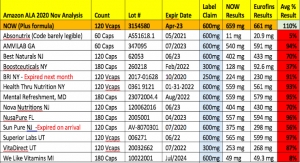Marie Spano, MS09.01.06
In seeking out products that help consumers look and feel young, they are often mesmerized by swanky packaging and touched-up marketing photos found in cosmeceutical ads. With a majority of people choosing such products to alter their outside appearance, what makes one look good often makes them feel good at the same time, thereby extending the benefits. Scientific-sounding verbiage is often used to market these products through magazines, on TV, in stores, through brochures/pamphlets in doctors' offices, on the Internet and through direct mail. Claims such as "stimulates cellular renewal and increases the number of fibroblasts," "recapture your skin's normal hormonal balance," and "target the inflammatory response" may be used even if the advertised product isn't based on science, or even on extrapolated science. Regardless, these claims still sound convincing enough for many consumers. Another successful marketing technique involves using words that hit on a deep emotion-how someone feels about their appearance.
Anti-aging is big business and growing rapidly. According to "Anti-aging Products and Services," a report from Business Communications Company, Norwalk, CT, Americans spent more than $41 billion on anti-aging products and services in 2003. At an average annual growth rate of 9.5%, this market is expected to reach $72 billion by 2009. Almost $280 million was spent on anti-aging products based on advanced technologies, with an average growth rate of over 12%2. According to "Industry Growth on the Horizon," an article published in Global Cosmetic Industry, the total amount spent in the U.S. on the combination of cosmetics and cosmeceuticals to improve the appearance of aging skin amounted $230 billion3. Though future growth is thought to be imminent, the direction of this growth depends on the development of new scientific research and how rapidly products based on this research can be created.
There are two laws that govern the cosmetics industry: the Federal Food, Drug, and Cosmetic Act (FD&C Act) and the Fair Packaging and Labeling Act (FPLA). The FD&C Act prohibits the marketing of adulterated or misbranded cosmetics resulting from ingredients, contaminants, processing, packaging and even shipping and handling. This act provides a measure of safety. The FPLA subjects companies to regulatory action if their products are improperly labeled, misbranded or deceptively packaged. FPLA also requires that cosmetic products declare their ingredients. With the exception of color additives, cosmetic products and ingredients are not subject to FDA pre-market approval. In other words, the onus is on the company to substantiate the safety of its product and ensure it is labeled properly4.
One popular trend in the promotion of anti-aging cosmeceuticals is to use dermatologists who develop their own product lines, with their name, credentials and face making up a good chunk of the marketing materials. One well known figure is Dr. Nicholas Perricone, who has taken his theories on inflammation to TV segments, four books and a thorough product line.
Patricia Wexler is another dermatologist with a product line bearing her name. Her philosophy is "Every skin is aging skin. You can try to prevent it or repair. My products do both."
Other popular trends include at-home versions of traditionally dermatologist-only beauty procedures, especially peels and microdermabrasion kits. In addition, different forms of common ingredients and new patented delivery systems are also very popular. The delivery of certain ingredients has changed to help maintain product stability while promising to deliver the specified ingredient to the skin more readily. A few systems include:
Niacyl: Provides the only continuous topical skin delivery system available for niacin, which has been clinically proven to strengthen and restore the skin's moisture barrier.
AOX+ advanced antioxidant technology: Combines ferulic acid with L-ascorbic acid to enhance antioxidant performance. Claims to use Duke-patented vitamin C technology, which delivers 15% L-ascorbic acid to the skin for maximum absorption.
Acetyl hexapeptide-3 (argireline): A molecule containing beeswax, carbomer, disodium EDTA, hydrogenated polydecenes, cetearyl alcohol, PEG-20 stearate, triethanolamine, avocado oil, rosehip oil, sweet almond oil and water. The manufacturer claims that this molecule inhibits neurotransmitter release similar to botox.
The majority of skin damage results from ultraviolet (UV) exposure. The resulting collective biochemical changes and alterations in structural integrity are termed photo damage. Collagen breakdown, chronic skin inflammation and the accumulation of abnormal elastin in the superficial dermis lead to wrinkles, mottled coloration and skin laxity5.
Many active ingredients found in anti-aging cosmeceuticals range from the more obscure, like sirtuin (from soybean cuticle fibers) and caviar extracts, to the very common, such as vitamin C. Is there enough sound scientific research to back up some of the more common ingredients? Yes and no.
Claims/Benefits: Powerful anti-inflammatory agent that also protects cells from free radical damage, improves collagen production, reduces the appearance of fine lines and wrinkles.
Research: Research does support the notion that alpha lipoic acid is a potent antioxidant with anti-inflammatory properties. In a double-blind, randomized clinical trial on 33 women aged 40-75, each subject treated half of their face twice daily with a cream containing 5% alpha lipoic acid and the other half of their face with an identical placebo cream without alpha lipoic acid for 12 weeks. The effectiveness of alpha lipoic acid was determined through self-evaluation by test subjects, clinical evaluation and photographic evaluation using laser profilometry.
All methods of assessment revealed statistically significant improvement in the alpha lipoic acid-treated side of the face in comparison to placebo, indicating that alpha lipoic acid is beneficial for the treatment of photo aging. More specifically, laser profilometry revealed an average decrease in skin roughness of 51%, compared to 41% on the untreated side6.
So if alpha lipoic acid can help treat already photo-damaged skin, can it prevent photo-damage in the first place? If a study using weanling Yorkshire pigs is any indication, the answer is no. In this experiment, a 5% alpha lipoic acid solution dissolved in 50% ethanol was compared to two commercial preparations, a 1% vitamin E + 15% vitamin C solution and an alpha lipoic acid formulation. All three were applied to different areas of shaved back skin and a 1000-W solar simulator was then used to induce UV radiation. Erythema was then measured. While the vitamin E+C commercial preparation provided significant protection, neither alpha lipoic acid product provided any benefit7.
Claims/Benefits: An amino acid that may help increase skin integrity.
Research: Preliminary research indicates that DMAE may have some benefit as part of an anti-aging regimen, although further research is necessary. DMAE is an analog of the B vitamin choline and a precursor of the neurotransmitter acetylcholine8. In vitro studies indicate that DMAE decreases protein cross linking, one hallmark of cellular aging that may be due to free radical damage9. In addition, DMAE may help prevent the aging process due to its role as a precursor of phosphatidylcholine, the primary phospholipids of cell membranes10. More research needs to be conducted to elucidate the potential mechanisms of action involving DMAE.
In one randomized, double-blind split face clinical study on 30 subjects, a 3% DMAE facial gel was applied daily and compared with the same formulation without DMAE. Shear wave propagation showed an increase in shear wave velocity indicating that DMAE helped increase skin firmness. These results were not significant11. In another double-blind, placebo-controlled study, 156 patients, aged 35-60 years used either DMAE gel or placebo gel for 16 weeks after which they were clinically evaluated. This clinician-rated assessment of overall skin appearance was significantly better in patients receiving DMAE vs. placebo12.
Claims/Benefits: Hyaluronic acid can be found both in skin care products and more often in injectables where it acts as a filler.
Research: Hyaluronic acid is present in the human body as a component of connective tissue where it provides a framework for the skin. It is FDA approved as a skin filler where it binds water providing volume to fill in areas such as nasolabial folds. As a filler it lasts approximately six months, though there are inter-individual differences. In skin care products, hyaluronic acid also binds water making it a great moisturizer.
Claims/Benefits: Improves skin texture, decreases the appearance of melasma, freckles, blotchy skin and fine lines.
Research: Kinetin is a synthetic cytokinin plant growth hormone that has been shown in vitro to delay the onset and decrease the extent of skin aging13,14. An in vitro study examined the effects of topical application of kinetin alone and combined with a mixture labeled ITP (biomarine complex, grape seed extract, tomato extract and vitamin C) on the organization of the epidermis, dermal-epidermal junction and dermis utilizing a reconstructed skin equivalent.
Kinetin alone stimulated keratinocyte (the major cell type of the epidermis making up 90% of this outer layer of skin) proliferation and differentiation in addition to formation of basement membrane and elastic network in the upper dermis (layer beneath the epidermis). The combination of kinetin and ITP led to greater keratinocyte proliferation and elastic network formation15.
Another in vitro study found that kinetin, EGCG (a component found in green tea), all-trans-retinoic acid and selenium induced changes in the aging-related proteins moesin, rho guanosine-5'-diphosphate-dissociation inhibitor, and actin, providing a possible mechanism for their role in preventing skin aging16.
An in vivo study examining the effects of kinetin applied twice a day for 24 weeks on patients with mild to moderate photo damage revealed a decrease in skin mottling, roughness and fine wrinkles17.
Claims/Benefits: Functions as a potent antioxidant; reduces wrinkling.
Research: Vitamin E is well established as an antioxidant that protects cell membranes from free radical damage. In a review of antioxidants found in skin tissue, alpha-tocopherol (one of the many forms of vitamin E) was discovered as the major antioxidant in human epidermal tissue18. However, consumption and topical application are two different things. As Rangarajan and Katz found, formulation determines permeability. They examined a few different alpha-tocopheryl acetate formulations: a simple isopropyl myristate (IPM) solution, an o/w emulsion, microemulsion (with a different oily phase content), and alcoholic and hydro alcoholic gels. The microemulsion was found to have the greatest permeability of pig skin (which closely resembles human skin) at 15-20%19. However, topical application has been found to be effective in decreasing skin wrinkling associated with UV damage in animal models20,21. Studies in humans are a bit more conflicting and it is still unclear if vitamin E can help more before, or after sun exposure.
Some other ingredients that can be found in anti-aging cosmeceuticals include rosemarinic acid (rosemary extract), vitamin C (ascorbic acid) and tea extracts. Though it sounds fancy, the botanical rosemarinic acid has little to no research to actually support the implied belief that this antioxidant-rich plant can benefit human skin.
Vitamin C, often labeled as ascorbic acid, may benefit consumers topically by helping enhance collagen production and indirectly helping to decrease its degradation. However, as a water-soluble vitamin, vitamin C is not very stable in skin care preparations, making absorbability an issue22 and therefore the vitamin C in many products useless. L-ascorbic acid, in particular, is very difficult to stabilize.
Tea drinking is associated with a multitude of health benefits, however, topical tea extracts, thought to have antioxidant and anti-inflammatory activity, may or may not be clinically effective. Thus far, it is too early to tell. Promising studies to date indicate that topical green tea extract may play a role in preventing sun damage. More research, however, is needed on this front and on the stability of tea extracts in topical preparations.
The future of anti-aging cosmeceuticals looks very bright. Research focusing on how damaging DNA changes can be mitigated and a better understanding on reversing damage, will help scientists create enhanced application systems and verify the benefits of a variety of ingredients, both alone and in combination. Aging cannot be reversed, but it can be slowed. However, most dermatologists will still agree that prevention is our best defense and the single best effective method for preventing aging involves staying out of the sun and slathering on sunscreen when you are outside. With a few top-notch products in hand and an overall healthy lifestyle, we can all look and feel younger.
1.Yaar, M., M. Eller & B. Gilchrest. 2002. Fifty years of skin aging. J. Invest. Dermatol. Symp. Proc. 7: 51�58.
2.Anti-aging Products and Services. Business Communications Company 2005.
3.Briney C. Industry Growth on the Horizon. Global Cosmetic Industry. 2005:41-42.
4.http://www.cfsan.fda.gov/~dms/cos-206.html.
5.Bosset S et al. Photoageing shows histological features of chronic skin inflammation without clinical and molecular abnormalities. Brit J Derm. 2003;149:826-835.
6.Beitner H. Randomized, placebo-controlled, double-blind study on the clinical efficacy of a cream containing 5% alpha-lipoic acid related to photoaging of facial skin. Brit J Derm 2003;149:841-849.
7.Lin JY et al. Alpha-lipoic acid is ineffective as a topical antioxidant for photoprotection of skin. J Invest Dermatol. 2004;123(5):996-8.
8.Grossman R. The role of dimethylaminoethanol in cosmetic dermatology. Am J Clin Dermatol. 2005;6(1):39-47. Review.
9.Nagy I, Nagy K. On the role of cross-linking of cellular proteins in aging. Mech Ageing Dev. 1980;14(1-2):245-51.
10.Zs-Nagy I. Pharmacological interventions against aging through the cell plasma membrane: a review of the experimental results obtained in animals and humans. Ann NY Acad Sci 2002;959:308-20.
11.Uhoda I et al. Split face study on the cutaneous tensile effect of 2-dimethylaminoethanol (deanol) gel. Skin Res Technol. 2002 Aug;8(3):164-7.
12.Grossman R et al. Safety and efficacy evaluation of a new skin firming technology: dimethylethanol and tyrosine. 60th Annual Meeting of the Academy of Dermatology. 2002; New Orleans.
13.Rattan S. I. S. and Clark B. F. C. Kinetin Delays the Onset of Aging Characteristics in Human Fibroblasts. Biochem Biophys Res Comm. 1994;201(2):665-672.
14.Rattan SI, Clark BF. Kinetin delays the onset of aging characteristics in human fibroblasts.Biochem Biophys Res Commun. 1994;201(2):665-72.
15.Vicanova J. Epidermal and dermal characteristics in skin equivalent after systemic and topical application of skin care ingredients. Ann NY Acad Sci 2006;1067:337-42.
16.Lee JH et al. Searching for aging-related proteins in human dermal microvascular endothelial cells treated with anti-aging agents.Proteomics. 2006 Feb; 6(4):1351-61.
17.McCullough JL, Weinstein JD. Clinical study of safety and efficacy of using topical kinetin 1% (Kinerase) to treat photodamaged skin. Cosmet Derma. 2002;15:29-32.
18.Thiele JJ et al. The antioxidant network of the stratum corneum. Curr Prob Dermatol 2001;29:26-42.
19.Rangarajan M, Zatz JL. Effect of formulation on the delivery and metabolism of alpha-tocopheryl acetate. J Cosmet Sci. 2001;52(4):225-36
20.Bisset DL et al. The hairless mouse as a model of skin photoaging; its use to evaluate photoprotective materials. Photodermatol Photoimmunol Photomed 1989;6:228-33.
21.Bisset DL et al. Photoprotective effect of superoxide-scavenging antioxidants against ultraviolet radiation-induced chronic skin damage in the hairless mouse. Photodermatol Photoimmunol Photomed 1989;7:56-62.
22. Colven RM, Pinnell SR. Topical vitamin C in aging. Clin Dermatol 1996;14:227-34.
Anti-aging is big business and growing rapidly. According to "Anti-aging Products and Services," a report from Business Communications Company, Norwalk, CT, Americans spent more than $41 billion on anti-aging products and services in 2003. At an average annual growth rate of 9.5%, this market is expected to reach $72 billion by 2009. Almost $280 million was spent on anti-aging products based on advanced technologies, with an average growth rate of over 12%2. According to "Industry Growth on the Horizon," an article published in Global Cosmetic Industry, the total amount spent in the U.S. on the combination of cosmetics and cosmeceuticals to improve the appearance of aging skin amounted $230 billion3. Though future growth is thought to be imminent, the direction of this growth depends on the development of new scientific research and how rapidly products based on this research can be created.
There are two laws that govern the cosmetics industry: the Federal Food, Drug, and Cosmetic Act (FD&C Act) and the Fair Packaging and Labeling Act (FPLA). The FD&C Act prohibits the marketing of adulterated or misbranded cosmetics resulting from ingredients, contaminants, processing, packaging and even shipping and handling. This act provides a measure of safety. The FPLA subjects companies to regulatory action if their products are improperly labeled, misbranded or deceptively packaged. FPLA also requires that cosmetic products declare their ingredients. With the exception of color additives, cosmetic products and ingredients are not subject to FDA pre-market approval. In other words, the onus is on the company to substantiate the safety of its product and ensure it is labeled properly4.
Anti-Aging Product Trends
One popular trend in the promotion of anti-aging cosmeceuticals is to use dermatologists who develop their own product lines, with their name, credentials and face making up a good chunk of the marketing materials. One well known figure is Dr. Nicholas Perricone, who has taken his theories on inflammation to TV segments, four books and a thorough product line.
Patricia Wexler is another dermatologist with a product line bearing her name. Her philosophy is "Every skin is aging skin. You can try to prevent it or repair. My products do both."
Other popular trends include at-home versions of traditionally dermatologist-only beauty procedures, especially peels and microdermabrasion kits. In addition, different forms of common ingredients and new patented delivery systems are also very popular. The delivery of certain ingredients has changed to help maintain product stability while promising to deliver the specified ingredient to the skin more readily. A few systems include:
Niacyl: Provides the only continuous topical skin delivery system available for niacin, which has been clinically proven to strengthen and restore the skin's moisture barrier.
AOX+ advanced antioxidant technology: Combines ferulic acid with L-ascorbic acid to enhance antioxidant performance. Claims to use Duke-patented vitamin C technology, which delivers 15% L-ascorbic acid to the skin for maximum absorption.
Acetyl hexapeptide-3 (argireline): A molecule containing beeswax, carbomer, disodium EDTA, hydrogenated polydecenes, cetearyl alcohol, PEG-20 stearate, triethanolamine, avocado oil, rosehip oil, sweet almond oil and water. The manufacturer claims that this molecule inhibits neurotransmitter release similar to botox.
Understanding Aging and Ingredients
The majority of skin damage results from ultraviolet (UV) exposure. The resulting collective biochemical changes and alterations in structural integrity are termed photo damage. Collagen breakdown, chronic skin inflammation and the accumulation of abnormal elastin in the superficial dermis lead to wrinkles, mottled coloration and skin laxity5.
Many active ingredients found in anti-aging cosmeceuticals range from the more obscure, like sirtuin (from soybean cuticle fibers) and caviar extracts, to the very common, such as vitamin C. Is there enough sound scientific research to back up some of the more common ingredients? Yes and no.
Alpha Lipoic Acid
Claims/Benefits: Powerful anti-inflammatory agent that also protects cells from free radical damage, improves collagen production, reduces the appearance of fine lines and wrinkles.
Research: Research does support the notion that alpha lipoic acid is a potent antioxidant with anti-inflammatory properties. In a double-blind, randomized clinical trial on 33 women aged 40-75, each subject treated half of their face twice daily with a cream containing 5% alpha lipoic acid and the other half of their face with an identical placebo cream without alpha lipoic acid for 12 weeks. The effectiveness of alpha lipoic acid was determined through self-evaluation by test subjects, clinical evaluation and photographic evaluation using laser profilometry.
All methods of assessment revealed statistically significant improvement in the alpha lipoic acid-treated side of the face in comparison to placebo, indicating that alpha lipoic acid is beneficial for the treatment of photo aging. More specifically, laser profilometry revealed an average decrease in skin roughness of 51%, compared to 41% on the untreated side6.
So if alpha lipoic acid can help treat already photo-damaged skin, can it prevent photo-damage in the first place? If a study using weanling Yorkshire pigs is any indication, the answer is no. In this experiment, a 5% alpha lipoic acid solution dissolved in 50% ethanol was compared to two commercial preparations, a 1% vitamin E + 15% vitamin C solution and an alpha lipoic acid formulation. All three were applied to different areas of shaved back skin and a 1000-W solar simulator was then used to induce UV radiation. Erythema was then measured. While the vitamin E+C commercial preparation provided significant protection, neither alpha lipoic acid product provided any benefit7.
DMAE (dimethylaminoethanol)
Claims/Benefits: An amino acid that may help increase skin integrity.
Research: Preliminary research indicates that DMAE may have some benefit as part of an anti-aging regimen, although further research is necessary. DMAE is an analog of the B vitamin choline and a precursor of the neurotransmitter acetylcholine8. In vitro studies indicate that DMAE decreases protein cross linking, one hallmark of cellular aging that may be due to free radical damage9. In addition, DMAE may help prevent the aging process due to its role as a precursor of phosphatidylcholine, the primary phospholipids of cell membranes10. More research needs to be conducted to elucidate the potential mechanisms of action involving DMAE.
In one randomized, double-blind split face clinical study on 30 subjects, a 3% DMAE facial gel was applied daily and compared with the same formulation without DMAE. Shear wave propagation showed an increase in shear wave velocity indicating that DMAE helped increase skin firmness. These results were not significant11. In another double-blind, placebo-controlled study, 156 patients, aged 35-60 years used either DMAE gel or placebo gel for 16 weeks after which they were clinically evaluated. This clinician-rated assessment of overall skin appearance was significantly better in patients receiving DMAE vs. placebo12.
Hyaluronic Acid
Claims/Benefits: Hyaluronic acid can be found both in skin care products and more often in injectables where it acts as a filler.
Research: Hyaluronic acid is present in the human body as a component of connective tissue where it provides a framework for the skin. It is FDA approved as a skin filler where it binds water providing volume to fill in areas such as nasolabial folds. As a filler it lasts approximately six months, though there are inter-individual differences. In skin care products, hyaluronic acid also binds water making it a great moisturizer.
Kinetin
Claims/Benefits: Improves skin texture, decreases the appearance of melasma, freckles, blotchy skin and fine lines.
Research: Kinetin is a synthetic cytokinin plant growth hormone that has been shown in vitro to delay the onset and decrease the extent of skin aging13,14. An in vitro study examined the effects of topical application of kinetin alone and combined with a mixture labeled ITP (biomarine complex, grape seed extract, tomato extract and vitamin C) on the organization of the epidermis, dermal-epidermal junction and dermis utilizing a reconstructed skin equivalent.
Kinetin alone stimulated keratinocyte (the major cell type of the epidermis making up 90% of this outer layer of skin) proliferation and differentiation in addition to formation of basement membrane and elastic network in the upper dermis (layer beneath the epidermis). The combination of kinetin and ITP led to greater keratinocyte proliferation and elastic network formation15.
Another in vitro study found that kinetin, EGCG (a component found in green tea), all-trans-retinoic acid and selenium induced changes in the aging-related proteins moesin, rho guanosine-5'-diphosphate-dissociation inhibitor, and actin, providing a possible mechanism for their role in preventing skin aging16.
An in vivo study examining the effects of kinetin applied twice a day for 24 weeks on patients with mild to moderate photo damage revealed a decrease in skin mottling, roughness and fine wrinkles17.
Vitamin E (alpha-tocopherol)
Claims/Benefits: Functions as a potent antioxidant; reduces wrinkling.
Research: Vitamin E is well established as an antioxidant that protects cell membranes from free radical damage. In a review of antioxidants found in skin tissue, alpha-tocopherol (one of the many forms of vitamin E) was discovered as the major antioxidant in human epidermal tissue18. However, consumption and topical application are two different things. As Rangarajan and Katz found, formulation determines permeability. They examined a few different alpha-tocopheryl acetate formulations: a simple isopropyl myristate (IPM) solution, an o/w emulsion, microemulsion (with a different oily phase content), and alcoholic and hydro alcoholic gels. The microemulsion was found to have the greatest permeability of pig skin (which closely resembles human skin) at 15-20%19. However, topical application has been found to be effective in decreasing skin wrinkling associated with UV damage in animal models20,21. Studies in humans are a bit more conflicting and it is still unclear if vitamin E can help more before, or after sun exposure.
Other Ingredients
Some other ingredients that can be found in anti-aging cosmeceuticals include rosemarinic acid (rosemary extract), vitamin C (ascorbic acid) and tea extracts. Though it sounds fancy, the botanical rosemarinic acid has little to no research to actually support the implied belief that this antioxidant-rich plant can benefit human skin.
Vitamin C, often labeled as ascorbic acid, may benefit consumers topically by helping enhance collagen production and indirectly helping to decrease its degradation. However, as a water-soluble vitamin, vitamin C is not very stable in skin care preparations, making absorbability an issue22 and therefore the vitamin C in many products useless. L-ascorbic acid, in particular, is very difficult to stabilize.
Tea drinking is associated with a multitude of health benefits, however, topical tea extracts, thought to have antioxidant and anti-inflammatory activity, may or may not be clinically effective. Thus far, it is too early to tell. Promising studies to date indicate that topical green tea extract may play a role in preventing sun damage. More research, however, is needed on this front and on the stability of tea extracts in topical preparations.
A Bright Future
The future of anti-aging cosmeceuticals looks very bright. Research focusing on how damaging DNA changes can be mitigated and a better understanding on reversing damage, will help scientists create enhanced application systems and verify the benefits of a variety of ingredients, both alone and in combination. Aging cannot be reversed, but it can be slowed. However, most dermatologists will still agree that prevention is our best defense and the single best effective method for preventing aging involves staying out of the sun and slathering on sunscreen when you are outside. With a few top-notch products in hand and an overall healthy lifestyle, we can all look and feel younger.
References
1.Yaar, M., M. Eller & B. Gilchrest. 2002. Fifty years of skin aging. J. Invest. Dermatol. Symp. Proc. 7: 51�58.
2.Anti-aging Products and Services. Business Communications Company 2005.
3.Briney C. Industry Growth on the Horizon. Global Cosmetic Industry. 2005:41-42.
4.http://www.cfsan.fda.gov/~dms/cos-206.html.
5.Bosset S et al. Photoageing shows histological features of chronic skin inflammation without clinical and molecular abnormalities. Brit J Derm. 2003;149:826-835.
6.Beitner H. Randomized, placebo-controlled, double-blind study on the clinical efficacy of a cream containing 5% alpha-lipoic acid related to photoaging of facial skin. Brit J Derm 2003;149:841-849.
7.Lin JY et al. Alpha-lipoic acid is ineffective as a topical antioxidant for photoprotection of skin. J Invest Dermatol. 2004;123(5):996-8.
8.Grossman R. The role of dimethylaminoethanol in cosmetic dermatology. Am J Clin Dermatol. 2005;6(1):39-47. Review.
9.Nagy I, Nagy K. On the role of cross-linking of cellular proteins in aging. Mech Ageing Dev. 1980;14(1-2):245-51.
10.Zs-Nagy I. Pharmacological interventions against aging through the cell plasma membrane: a review of the experimental results obtained in animals and humans. Ann NY Acad Sci 2002;959:308-20.
11.Uhoda I et al. Split face study on the cutaneous tensile effect of 2-dimethylaminoethanol (deanol) gel. Skin Res Technol. 2002 Aug;8(3):164-7.
12.Grossman R et al. Safety and efficacy evaluation of a new skin firming technology: dimethylethanol and tyrosine. 60th Annual Meeting of the Academy of Dermatology. 2002; New Orleans.
13.Rattan S. I. S. and Clark B. F. C. Kinetin Delays the Onset of Aging Characteristics in Human Fibroblasts. Biochem Biophys Res Comm. 1994;201(2):665-672.
14.Rattan SI, Clark BF. Kinetin delays the onset of aging characteristics in human fibroblasts.Biochem Biophys Res Commun. 1994;201(2):665-72.
15.Vicanova J. Epidermal and dermal characteristics in skin equivalent after systemic and topical application of skin care ingredients. Ann NY Acad Sci 2006;1067:337-42.
16.Lee JH et al. Searching for aging-related proteins in human dermal microvascular endothelial cells treated with anti-aging agents.Proteomics. 2006 Feb; 6(4):1351-61.
17.McCullough JL, Weinstein JD. Clinical study of safety and efficacy of using topical kinetin 1% (Kinerase) to treat photodamaged skin. Cosmet Derma. 2002;15:29-32.
18.Thiele JJ et al. The antioxidant network of the stratum corneum. Curr Prob Dermatol 2001;29:26-42.
19.Rangarajan M, Zatz JL. Effect of formulation on the delivery and metabolism of alpha-tocopheryl acetate. J Cosmet Sci. 2001;52(4):225-36
20.Bisset DL et al. The hairless mouse as a model of skin photoaging; its use to evaluate photoprotective materials. Photodermatol Photoimmunol Photomed 1989;6:228-33.
21.Bisset DL et al. Photoprotective effect of superoxide-scavenging antioxidants against ultraviolet radiation-induced chronic skin damage in the hairless mouse. Photodermatol Photoimmunol Photomed 1989;7:56-62.
22. Colven RM, Pinnell SR. Topical vitamin C in aging. Clin Dermatol 1996;14:227-34.


























